Lebanon enjoys a rich and diverse cultural heritage. It is a country of different ethnic groups and religions with eighteen state-recognized confessions, including Christian and Muslim denominations and other minority groups. Lebanon has long attracted renowned intellectuals and artists from the Arab world, including artists and intellectuals from Palestine, Iraq, Syria, and Egypt. Such attractions allowed the country to draw on many Arab customs. Still, many of Lebanon's culture draws on European influences. This is partly because Lebanon was under French colonial rule for two decades (1923-1943) and due to the country's geographic proximity to Europe.
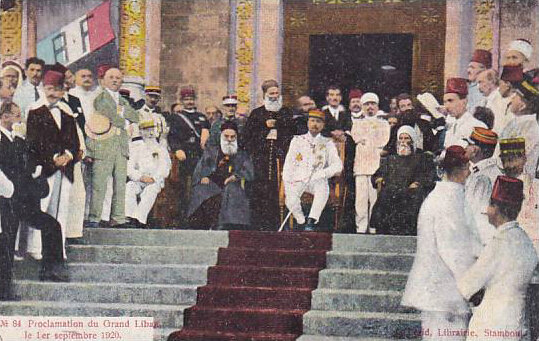
In many respects, Lebanon is partly a Francophone country. Early on, the French language was central to the Lebanese educational system and the state's administration. In addition, French and American embassies pursued a plan of cultural diplomacy in the region. For instance, the Institut Français du Proche Orient (IFPO) in Beirut, archaeology in coordination with Lebanese and international institutions, became an advocate of research development in history and archaeology.1 Similarly, for decades, the American cultural office in Beirut worked on assisting in supporting art and cultural projects.2
Lebanon’s cultural identity has always been contested due to the varied influences of Arab, Phoenician, and French culture. The country's artistic productions manifested such contestations between Lebanon's Arabness and non-Arabness. Lebanese intellectuals stressed on the importance of developing an organized relationship between the state and its cultural players, and artists of different sectors.
At a later point in Lebanese history, the presence of key political players whose interests intersected with those of Lebanese intellectuals and artists initiated a process that began to formalize their relationship with the state. Thus, after Lebanon’s independence in 1943, the state began to play a bigger organizing role in the art culture.
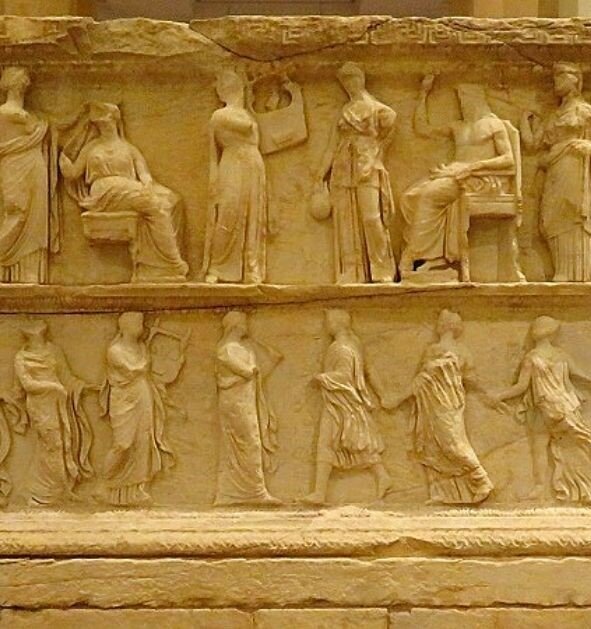
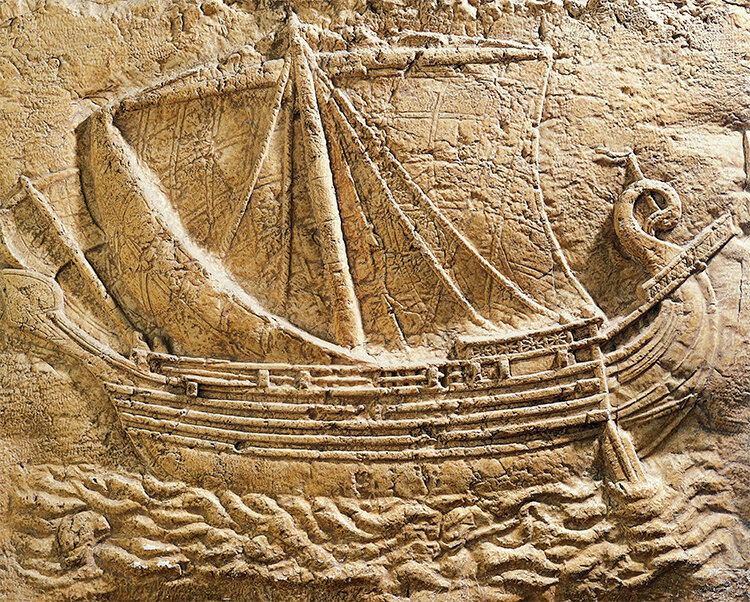
Proposal for a Lebanese Ministry of Culture (1971)
In 1943, the newly independent government established the Ministry of National Education and Fine Arts. The ministry was the governing body of national education, arts and culture. However, the ministry’s role was still minimal. Cultural activities such as the famous annual Baalbek Festivals as well as the initiatives promoting to protect archaeological and heritage sites were organized by the Ministry of Tourism; whereas cultural exchange was associated with the Ministry of Interior or the Ministry of Foreign Affairs. Intellectuals and cultural activists called for creating an all-inclusive Ministry of Culture. Ghassan Tueni3, the minister of National Education and Fine arts at the time, proposed a draft law to establish an autonomous Ministry of Culture.4 Besides being a politician and a diplomat, Ghassan Tueni was a journalist who headed an-Nahar newspaper - founded by his father Gibran in 1924 – assuming the role of editor-in chief and editor-publisher from 1948 till 1999 and from 2003-till 2012.
On January 13, 1971, Ghassan Tueni presented the proposal bill to the council of ministers. He suggested that the existing Ministry of National Education and Fine Arts be split into two separate ministries: A Ministry of Culture with an Institute of Fine Arts as part of it, and a Ministry of Education and Teaching. Tueni emphasized the role of artists in cultural production and advocated having artists integrated to the state’s structure.5 In addition, the ministry’s role entails that it preserves Lebanon’s cultural heritage and maintains its intellectual and artistic development. The proposal for such a ministry of culture was designed to set Lebanon's cultural policy - a vision of the Lebanese culture within strategic courses of action.
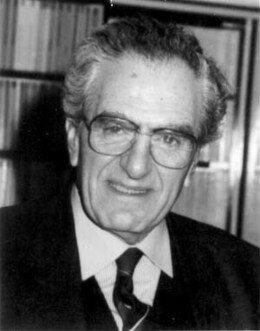
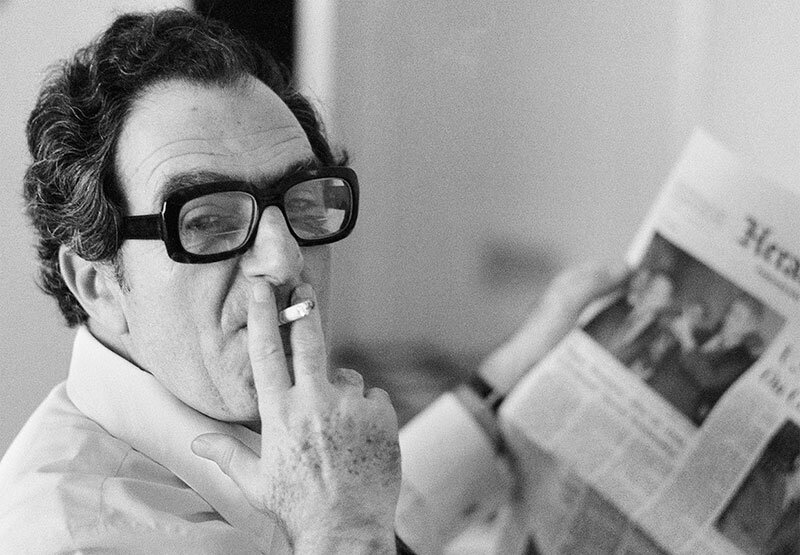
Intervention of the Lebanese Artists Association for Painting and Sculpture (1971)
The Lebanese Artists Association for Painting and Sculpture (LAAPS) intervened publishing a statement with a list of demands previously submitted to the minister Ghassan Tueni. Demands included establishing a Ministry of Culture, and a national museum for contemporary art. Also, they demanded a set of regulations to protect Lebanese artistic productions and standards that would elevate art education. Most importantly, artists requested a considerable fund for cultural activities and insisted that the state should not censor or interfere in their artistic freedom and autonomy.
On January 15, 1971, Jean Khalife, painter and president of the (LAAPS) from 1967-1971, attended the meeting set by Tueni at the UNESCO to discuss the establishment of a ministry of culture. Khalife shared the association’s demands with the minister (fig.1). He emphasized the point of intellectual and artistic freedom and expressed his surprise that both the Interior design and Architecture faculties were not put under the Ministry of Culture's umbrella (fig.2). Khalife advised that those two sectors belonging to the plastic arts be part of the ministry's responsibility.6

Tueni’s (1971) Proposal never saw the light of day!
Ghassan Tueni’s draft law (fig.3&4) submitted to the Lebanese parliament on January 13, 1971, for study and approval, never saw the light of day. On January 20, 1971, only three months after his appointment, to the surprise of many, Ghassan Tueni submitted his resignation. Due to multiple political roadblocks, he realized that he cannot execute the objectives he had set forth. In this regard, Tueni said, “If I am in power, it is to practice it, and not to be an honorary minister”7.
Tueni was deposed as a minister of National Education and Fine arts and replaced by Najib Abu Haydar. Haydar was a medical doctor specialized in endocrinology, before he attended to public affairs and politics. Not long after, the Lebanese civil war erupted in 1975. Most cultural projects were put on hold and the plan to establish a Ministry of Culture was suspended.8
What did the proposal for a Ministry of Culture (1971) present?
The Ministry of Culture was set up to promote the arts and culture industry, manage public affairs, and protect Lebanese heritage. The industry included the fine arts such as painting, sculpture, engraving, printing, photography, and theatre, but excluded interior design and architecture. It was meant to organize media and art productions and academic publications including literary publications, public seminars, academic conferences, cinema, and licensed festivals. Above all, the ministry was meant to ensure Lebanese citizens’ right to freedom of expression and provide job opportunities. In this respect, the Ministry of Culture, which did not see the light of day, would have consisted of the following:
- - The General Directorate of Cultural Activities: responsible for cinema, theatre, music, dance, and fine arts, thus replacing the National Conservatory for Music and merging it within the ministry.
- - National Institute of Fine Arts for Higher Education: responsible for setting pedagogical policy of fine arts education and monitor and evaluate artistic production. The National Institute of Fine Arts for Higher Education would replace the Lebanese University’s (UL) Institute of Fine Arts; and courses such as theatre, photography, painting, sculpting, etching, and printing would be offered at its faculties and canceled from the Lebanese University (UL).
- - The General Directorate of Youth and Public Activities: responsible for managing the Camille Chamoun Sports City Stadium in Beirut and sports clubs and their associated tournaments; as well as organizing activities favored by trends in the popular culture.
- - The Directorate of Cultural Centers: responsible for establishing Departments of Continuing Education and Education for the Elderly.
- - The General Directorate of Archaeology and the Directorate of Antiquities and Heritage Protection, previously part of the Ministry of Tourism, were to be come under the Ministry of Culture.
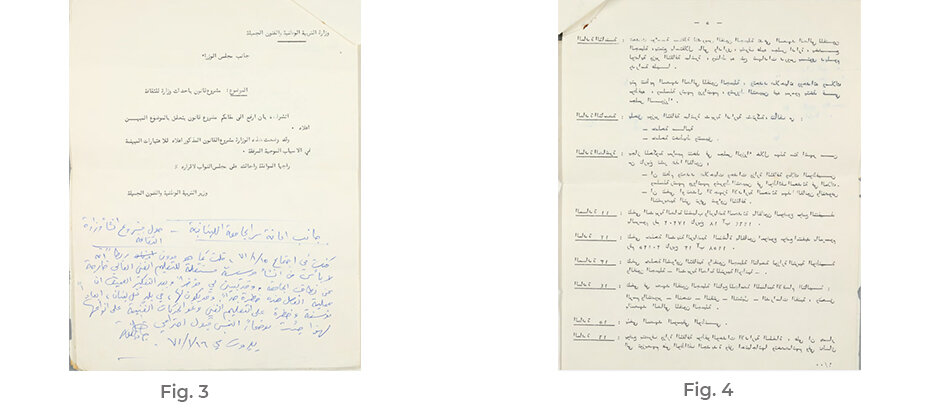
Creation of a National Committee for the Visual Arts (1971)
Instead of a Ministry of Culture, Najib Abu Haydar the newly appointed minister of National Education and Fine arts established a ‘National Committee for the Visual Arts’ on July 28, 1971,
(fig.7). The committee's role was to activate national and international cultural exchange with Lebanon's affiliated countries. 9During that period, many cultural events and exhibitions in the capital featured artworks by Syrian, Iraqi, and Egyptian artists.
The committee included the general director of the Ministry of National Education and Fine Arts, the head of the Cultural Affairs and Fine Arts state department, the director of the (UL) Institute of Fine Arts, the president of the Lebanese Academy of Fine Arts (ALBA), president of the Lebanese Artists Association for Painters and Sculptors (LAAPS), and representatives of the Sursock Museum and the Gibran Khalil Gibran Museum. In addition, active contemporary visual artists such as Jean Khalife, Elie Kanaan, Aref Rayess, Rachid Wehbe, Moazzaz Rawda, and Nadia Saikali were included as committee members.10
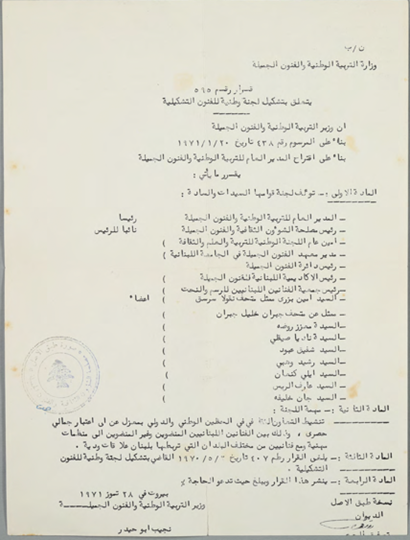
The Lebanese Ministry of Culture Today
When the Lebanese civil war ended in 1990, a ministry related to cultural affairs was eventually established in 1993 as part of the Ministry of Higher Education. The ensemble was called the Ministry of Culture and Higher Education,11 and headed by Minister Michèle Eddeh. Concurrently, Minister Hassan Ezzedeen created and headed the Ministry for Technical and Professional Education. Lastly, Minister Michael El Daher created and headed the Ministry of National Education and Fine Arts. The three newly established ministries lasted from 1995 until the year 2000, the However, the fine arts sector was replaced by the Ministry of Youth and Sports.
It was not until the year 2000 that the Ministry of Culture became an entity of its own, thus separating "higher education" from "culture." 12 In 2008, a set of decrees set up the Ministry of Culture’s current organizational structure. Today, the ministry comprises of the Directorate General of Cultural Affairs and the Directorate General of Archaeology.
However, the Ministry of Culture still has limited responsibilities and is often short on budget. For example, "The estimated fund for local production of the Ministry of Culture was established in 2015, accounting for 1.56% of the Lebanese government's total budget.13" As a result, the Ministry of Culture became a sector that depends on the patronage of private financiers such as banks, large corporations, affluent families, and on external funding through donor organizations and institutions. Today, the institutions which are under the Ministry of Culture include:
- - The Directorate of Antiquities and Museums
- - The Lebanese National Library in Sanaye’, Beirut and in Ba’akleen, mount Lebanon.
- - The National Museum and the Beirut Museum of Arts (BEMA) – a virtual museum.
- - The National Conservatory of Music.
- - The International Center for Human Sciences (CISH) in Byblos.
- - The Lebanese National Committee for Education, Science, and Culture.
Other state institutions also played a role in developing the cultural sector in Lebanon. For instance, the Ministry of Tourism organizes festivals and promotes archaeological sites. The Ministry of Interior and Municipalities authorizes and registers cultural associations and oversees cultural events arranged by the municipalities. Also, the Ministry of Education awards certificates in arts and culture and The Ministry of Social Affairs oversees crafts. The Ministry of Foreign Affairs is responsible for international cultural exchange. And lastly, the Ministry of Finance became a crucial factor in deciding what state funds should be assigned to cultural policies or cultural practices14.
This newly established system facilitated the development of an independent cultural sector in various artistic fields throughout Lebanon. However, it weakened the Ministry of Culture as an entity, thus limiting and reducing its role. As such, the Ministry of Culture became an intermediary through which funds for official projects get approved, or more accurately, a moral sponsor of cultural events. One of the key questions that linger to this day is: will the objectives of an independent Ministry of Culture proposed by Ghassan Tueni in 1971 ever be realized, addressed, or evoked? And if yes, what shape would they take? What kind of relationship should state institutions develop with artists and the art scene in Lebanon?



Comments on The Establishment of a Ministry of Culture in Lebanon